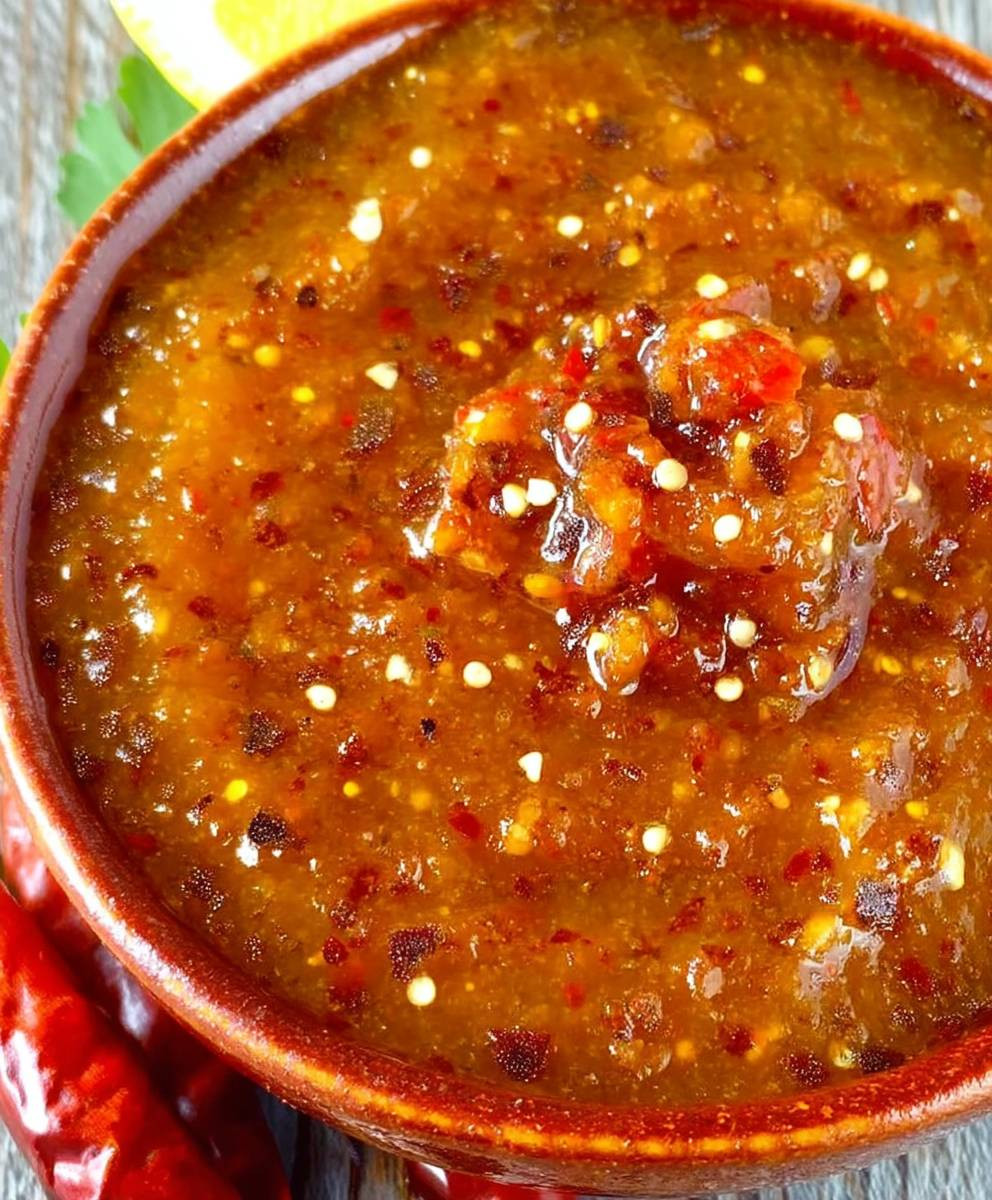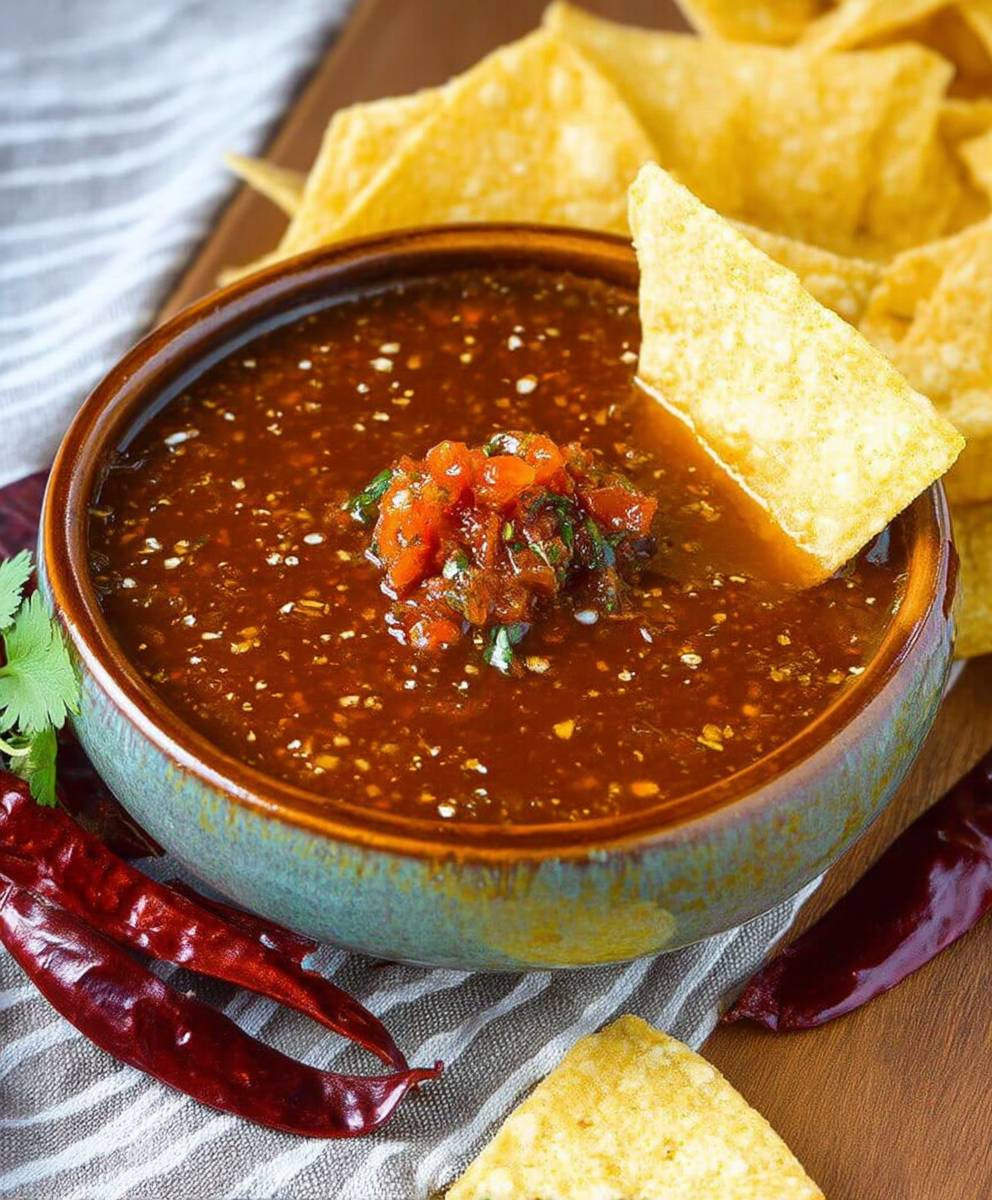Chile de Arbol Salsa: Prepare to ignite your taste buds with a vibrant, fiery condiment that will transform your meals from ordinary to extraordinary! Have you ever craved a salsa that delivers a serious kick, balanced with a smoky, nutty depth? Then look no further. This isn’t your average, run-of-the-mill salsa; it’s a flavor explosion waiting to happen.
Mexican cuisine is renowned for its bold and complex flavors, and salsa plays a starring role. While countless variations exist, Chile de Arbol Salsa holds a special place, particularly in regions where these potent little peppers thrive. The chile de árbol, meaning “tree chili,” is a small but mighty pepper that packs a significant punch of heat. Its use in salsas dates back centuries, a testament to its enduring appeal and ability to elevate simple ingredients.
People adore this salsa for its intense flavor profile. The initial heat is followed by a subtle smokiness and a hint of nuttiness, creating a complex and satisfying experience. Its versatility is another major draw. Drizzle it over tacos, eggs, grilled meats, or even vegetables for an instant flavor boost. Plus, making your own Chile de Arbol Salsa at home is surprisingly easy and allows you to customize the heat level to your preference. Get ready to experience a salsa that’s both bold and unforgettable!
Ingredients:
- 1 ounce dried chiles de árbol (about 20-30 chiles, depending on size)
- 2 cloves garlic, unpeeled
- 1/4 white onion, roughly chopped
- 1/2 teaspoon dried oregano
- 1/4 teaspoon ground cumin
- 1/4 cup water, plus more as needed
- 1 tablespoon white vinegar
- 1 teaspoon salt, or to taste
- 1/4 teaspoon black pepper, or to taste
- 1 tablespoon olive oil (optional, for roasting)
Preparing the Chiles:
Okay, let’s get started! The key to a really flavorful chile de árbol salsa is properly preparing the chiles. We want to coax out all those delicious smoky and spicy notes.
- Toast the Chiles: This step is crucial! Grab a large, dry skillet (cast iron is great if you have one) and place it over medium heat. Add the dried chiles de árbol. We’re going to toast them for just a few minutes, until they become fragrant and slightly pliable. Be careful not to burn them, as this will make the salsa bitter. Keep a close eye on them and flip them frequently. You’ll know they’re ready when they start to release their aroma and their color deepens slightly. This usually takes about 2-3 minutes. Remove the chiles from the skillet and set them aside to cool slightly.
- Toast the Garlic and Onion (Optional): While the skillet is still hot, you can add the unpeeled garlic cloves and the roughly chopped onion. Toast them until they are slightly charred and softened. This will add another layer of flavor to the salsa. If you prefer a fresher, less intense garlic and onion flavor, you can skip this step and add them raw later. Remove from the skillet and set aside.
- Rehydrate the Chiles: Now, we need to rehydrate the chiles to soften them up for blending. There are a couple of ways to do this. The first is to simply place the toasted chiles in a bowl and cover them with boiling water. Let them soak for about 15-20 minutes, or until they are soft and pliable. The second method, which I prefer because it adds even more flavor, is to simmer the chiles in water. Place the toasted chiles in a small saucepan and add enough water to cover them. Bring the water to a simmer over medium heat and let them simmer for about 10-15 minutes, or until they are soft.
- Remove Stems and Seeds (Optional): Once the chiles are rehydrated, you can remove the stems and seeds. This will reduce the heat of the salsa. If you like a really spicy salsa, you can leave some or all of the seeds in. I usually remove most of the seeds, but I leave a few in for a little extra kick. To do this, simply cut off the stem end of each chile and shake out the seeds. Be careful not to touch your eyes after handling the chiles!
Blending the Salsa:
Alright, the chiles are ready, the garlic and onion are toasted (or not!), and now it’s time to blend everything together into a beautiful, fiery salsa.
- Combine Ingredients in a Blender: Place the rehydrated chiles (and the soaking liquid, if you simmered them), toasted garlic and onion (if using), oregano, cumin, water, vinegar, salt, and pepper in a blender.
- Blend Until Smooth: Blend everything together until it is completely smooth. You may need to stop the blender a few times and scrape down the sides to ensure that everything is evenly blended. If the salsa is too thick, add a little more water until it reaches your desired consistency. I like mine to be slightly thick, but still pourable.
- Taste and Adjust Seasoning: This is a crucial step! Taste the salsa and adjust the seasoning as needed. You may need to add more salt, pepper, vinegar, or even a pinch of sugar to balance the flavors. If it’s not spicy enough, you can add a pinch of cayenne pepper or a few more chile seeds. If it’s too spicy, you can add a little more water or vinegar.
Cooking the Salsa (Optional):
While you can certainly enjoy the salsa right after blending, I find that cooking it briefly really helps to meld the flavors together and create a smoother, more complex taste. This step is optional, but I highly recommend it.
- Heat Olive Oil (Optional): If you’re using olive oil, heat it in a small saucepan over medium heat. The olive oil adds a richness to the salsa, but you can skip it if you prefer a lighter flavor.
- Sauté the Salsa: Pour the blended salsa into the saucepan and bring it to a simmer. Reduce the heat to low and let it simmer for about 5-10 minutes, stirring occasionally. This will allow the flavors to meld together and the salsa to thicken slightly. Be careful not to let it burn.
Serving and Storing:
Congratulations! You’ve made your own homemade chile de árbol salsa. Now it’s time to enjoy it!
- Cool and Store: Let the salsa cool completely before transferring it to an airtight container. Store it in the refrigerator for up to a week. The flavors will actually develop and improve over time.
- Serving Suggestions: This salsa is incredibly versatile. You can use it as a condiment for tacos, burritos, enchiladas, quesadillas, and other Mexican dishes. It’s also great with eggs, grilled meats, vegetables, and even chips and salsa. I love to drizzle it over my breakfast tacos in the morning!
Tips and Variations:
- Spice Level: The heat of the salsa will depend on the type and quantity of chiles de árbol you use. If you’re sensitive to spice, start with fewer chiles and remove all of the seeds. You can always add more later if you want it spicier.
- Roasting the Chiles: For an even deeper, smokier flavor, you can roast the chiles in the oven instead of toasting them in a skillet. Preheat your oven to 400°F (200°C). Spread the chiles on a baking sheet and roast them for about 5-7 minutes, or until they are fragrant and slightly pliable. Be sure to watch them carefully so they don’t burn.
- Adding Tomatoes: For a slightly sweeter and less spicy salsa, you can add a roasted tomato or two to the blender.
- Adding Other Vegetables: Feel free to experiment with other vegetables, such as roasted bell peppers or tomatillos.
- Using Different Vinegars: You can use different types of vinegar, such as apple cider vinegar or rice vinegar, to add different flavor notes to the salsa.
- Fresh Herbs: A little bit of fresh cilantro or parsley can add a bright, fresh flavor to the salsa. Add it to the blender at the end.
- Make it Ahead: This salsa is even better the next day, so feel free to make it ahead of time.
Enjoy your delicious homemade chile de árbol salsa! I hope you love it as much as I do. It’s a staple in my kitchen, and I use it on everything. Let me know in the comments how you like to use your salsa!

Conclusion:
This Chile de Arbol Salsa isn’t just another condiment; it’s a flavor explosion waiting to happen! I truly believe this recipe is a must-try for anyone who appreciates authentic Mexican flavors and a good kick of heat. The combination of the smoky, nutty chile de árbol peppers with the bright acidity of the tomatoes and the subtle sweetness of the garlic creates a salsa that’s complex, addictive, and incredibly versatile. It’s the kind of salsa that will have you reaching for more, long after your taste buds have started to tingle.
But what truly sets this recipe apart is its simplicity. You don’t need any fancy equipment or hard-to-find ingredients. With just a handful of pantry staples and a little bit of patience, you can create a salsa that rivals anything you’d find in a restaurant. And trust me, the homemade touch makes all the difference.
So, why is this a must-try? Because it’s:
* Incredibly flavorful: The chile de árbol peppers provide a unique smoky heat that’s both satisfying and addictive.
* Easy to make: The recipe is straightforward and requires minimal effort.
* Versatile: It can be used in countless ways, from topping tacos to adding a kick to your breakfast eggs.
* Authentic: It captures the true essence of Mexican cuisine.
* Customizable: You can adjust the heat level to your liking by adding or subtracting peppers.
Now, let’s talk about serving suggestions and variations. While this salsa is fantastic on its own with tortilla chips, its versatility truly shines when paired with other dishes. Imagine drizzling it over crispy tacos al pastor, spooning it onto cheesy quesadillas, or using it as a marinade for grilled chicken or steak. It’s also incredible with breakfast burritos, huevos rancheros, or even just a simple scrambled egg.
For variations, consider adding a touch of sweetness with a drizzle of honey or agave nectar. You could also experiment with different types of peppers, such as guajillo or chipotle, to create a unique flavor profile. If you prefer a smoother salsa, you can blend it for a longer period of time. And for a richer flavor, try roasting the tomatoes and garlic before blending.
Here are a few more ideas to get you started:
* As a marinade: Marinate chicken, steak, or shrimp in the salsa for at least 30 minutes before grilling or baking.
* As a topping: Spoon it over tacos, enchiladas, burritos, or quesadillas.
* As a dip: Serve it with tortilla chips, vegetables, or even grilled meats.
* In soups and stews: Add a spoonful to your favorite soup or stew for a boost of flavor and heat.
* With eggs: Drizzle it over scrambled eggs, omelets, or huevos rancheros.
I truly hope you’ll give this Chile de Arbol Salsa recipe a try. I’m confident that you’ll love it as much as I do. Once you’ve made it, I’d love to hear about your experience! Share your photos and comments on social media using [Your Hashtag] and let me know what you think. Did you make any variations? What did you serve it with? I’m always eager to learn from my readers and see how you’re making this recipe your own. Happy cooking!
Chile de Arbol Salsa: The Ultimate Guide to Flavor and Heat
Fiery and flavorful homemade Chile de Árbol Salsa. Perfect for tacos, eggs, and more!
Ingredients
Instructions
Recipe Notes
- Spice Level: Adjust the amount of chiles and seeds to control the heat.
- Roasting the Chiles: For a smokier flavor, roast the chiles in the oven at 400°F (200°C) for 5-7 minutes.
- Cooking the Salsa: Cooking the salsa is optional but recommended for a smoother, more complex flavor.
- Make Ahead: Salsa tastes even better the next day.




